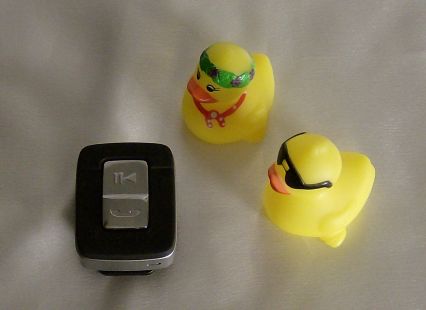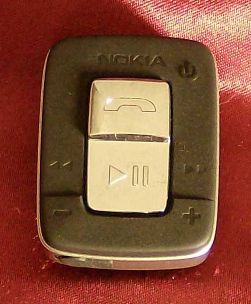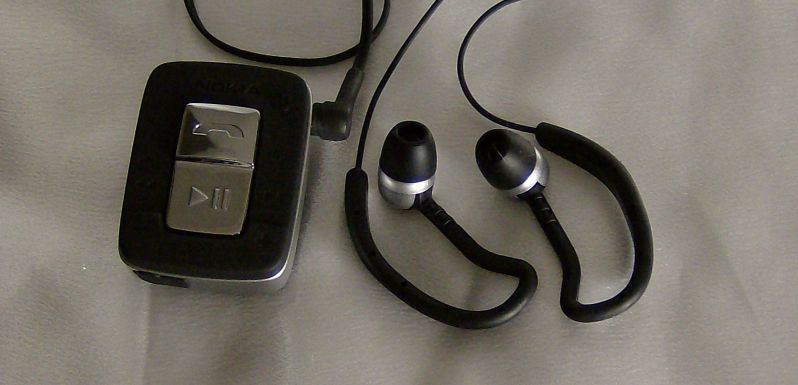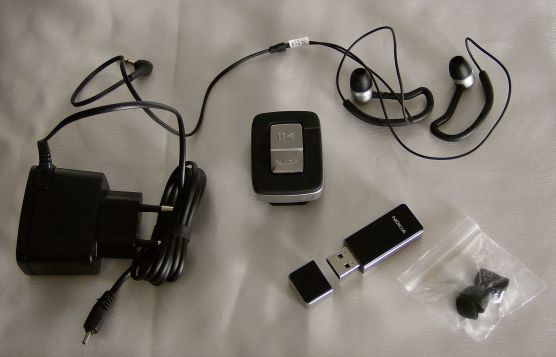Review: Nokia BH-500 Stereo Bluetooth Headset
Score:
85%
Nokia BH-500 Stereo Bluetooth Headset
 The idea behind the BH-500 is simple: it lets you turn any standard headphones into stereo Bluetooth headphones by plugging them into the BH-500's 3.5mm socket (and you're not restricted to headphones, speakers and audio cables work too). The accessory itself contains no built-in headphones, is very small and light, weighs 40 grams and has a thick sturdy clip to attach it to your clothes or bag. It's coated in rubber, with a flap over the charging socket, and is apparently splash proof and dust proof.
The idea behind the BH-500 is simple: it lets you turn any standard headphones into stereo Bluetooth headphones by plugging them into the BH-500's 3.5mm socket (and you're not restricted to headphones, speakers and audio cables work too). The accessory itself contains no built-in headphones, is very small and light, weighs 40 grams and has a thick sturdy clip to attach it to your clothes or bag. It's coated in rubber, with a flap over the charging socket, and is apparently splash proof and dust proof.
You can use it to listen to music on all A2DP-compatible devices, which includes phones, music players and computers, including S60 devices such as the Nokia N91 8GB, N95, 5700 and 6110, among others. You can pair the BH-500 with up to eight different devices, although obviously you can only use it with one at a time.
The BH-500 is also compatible with the AVRCP, Headset and Handsfree Bluetooth profiles. AVRCP (Audio Video Remote Control Profile) lets the BH-500 control a device's multimedia functions, using its own play/pause, forward and backward buttons. It also has its own volume control and a call handling button. The play/pause and call controls are very large silver buttons in the middle, with the other controls are embedded in the black rubber surround.
The sales package includes the BH-500, some standard headphones (although you might want to use your own ones, that is after all the point of this thing!), three sizes of rubber headphone buds, a Nokia AD-47W Bluetooth USB adaptor (which lets you use the BH-500 with your PC) and a standard Nokia charger.
Getting Started
 Charging takes about 90 minutes and gives you eight hours of music playback, or about six days standby (with the Bluetooth on but unused). There's a multi-coloured LED buried underneath the black rubber which is yellow during charging and turns green when it's full.
Charging takes about 90 minutes and gives you eight hours of music playback, or about six days standby (with the Bluetooth on but unused). There's a multi-coloured LED buried underneath the black rubber which is yellow during charging and turns green when it's full.The BH-500 doesn't have a keypad, so its fixed Bluetooth pairing code is printed in the manual, and you enter it on your phone during the pairing process. After pairing, Nokia A2DP-compatible phones also give you the option of automatically connecting to the headset whenever it's switched on. I found this option very useful indeed.
One slightly confusing (and undocumented) complication is the dual nature of the power switch on the BH-500. If you hold it down until a green light appears, and then release it, it will connect to your phone without any problems, and the light will then turn blue to indicate the Bluetooth connection is established. However, if you turn the BH-500 on by holding down the power switch beyond the green light, it eventually turns blue and refuses to connect to your phone. This seems to be the BH-500's PC mode, which you use when connecting it to your computer, but more about that later.
Using the BH-500 is fairly straightforward. The music controls are identical to those on the phone, and the volume level is totally separate from the phone's. The call handling button lets you answer calls, end them, or dial the last used number if you press it twice. There's a built-in microphone in the BH-500 so you can handle calls without taking your phone out of your pocket or bag. The microphone seems to work well even when worn quite a way from your mouth.
Unfortunately you can't listen to your phone's FM radio, mobile devices require wired headphones attached to them to act as their FM aerial.

Sound Quality
But how good is the sound? Well, the answer is: how good are your headphones? Various manufacturers' headphones sounded as they did when directly connected to the phone, so it seems that the BH-500 doesn't noticeably affect the audio signal it handles, at least to my ears.The BH-500's signal proved consistent over the usual Bluetooth range of 10 metres. As a more extreme test, I left the phone in a room at one end of the flat and walked to a room at the other, which was about 10 or 12 metres away with two walls between us. The signal quality didn't change, although it broke up very briefly but then returned and stabilised (perhaps the phone increased its signal strength to make up for the greater distance). If I walked further than that, with three or more walls in between, the signal broke up and never stabilised, but it kept the connection open and returned to normal if I walked back towards the phone.
Using decent headphones makes phone calls themselves sound surprisingly good, and it's actually quite fun to take calls using the BH-500, although as with all headsets it looks a bit odd in public if you're talking by yourself and there's no phone in sight.
The devices you pair with the BH-500 seem to affect sound quality. With the non-smart Nokia 5300 phone there was some stuttering between tracks as the phone tried to cope with handling the music and handling the Bluetooth signal simultaneously. With a PC there was absolutely no stuttering between tracks at all.
Now time for a small confession: the Finnish branch of All About Symbian doesn't currently have an A2DP compatible S60 device to test the BH-500 with, so I can't say how well it works with S60 phones. However, we should be getting a 5700 to review at some point, so expect an update to this article. [The 6290 will be back with you within a week! - Ed]

PC Use
The AD-47W Bluetooth adaptor included with the BH-500 is a USB dongle which plugs into your computer and lets you use the BH-500 with it. There's no set up required, just plug it in and it works, although you may need to press a button on the dongle to get it connected to the BH-500. Windows PCs (and possibly others too) automatically switch to a different set of volume controls, which you can access by clicking on the usual volume control icon next to the system clock.As stated above, to put the BH-500 in computer mode you have to switch it on by holding down the power button until the green light turns blue. If the USB dongle doesn't automatically connect to the BH-500, try pressing the dongle's button. When the connection is established, the dongle's blue LED will remain lit instead of blinking.
The BH-500 works fine with the PC, and might be used for (for example) listening to internet radio or PC-stored music in rooms near your PC. I couldn't get the BH-500's multimedia controls to work with my computer, but presumably an AVRCP-compatible computer wouldn't have problems.
Overall
People often have their own favourite headphones, so it's nice that a device exists that can turn them all into Bluetooth headphones. The unavoidable downside is that you still end up with wires, because that's what standard headphones use. (Having said that, the headphones included in the sales package do have an extremely short cable to minimise the problem.)
What the BH-500 does in effect is act as a sort of phone-connected version of the clip-on iPod Shuffle, giving you a small, wearable set of music and call controls in a durable and barely noticeable package. Walking through a dodgy area of town, or just being caught in the rain, I'd much rather use the BH-500 than fish an expensive phone out of a bag or pocket.
Krisse, AllAboutSymbian, 15 May 2007
PS: If you'd like to see a video of the BH-500 as well as high resolution photographs, pop on over to the Nokia Duck blog's BH-500 page.
Reviewed by krisse at
